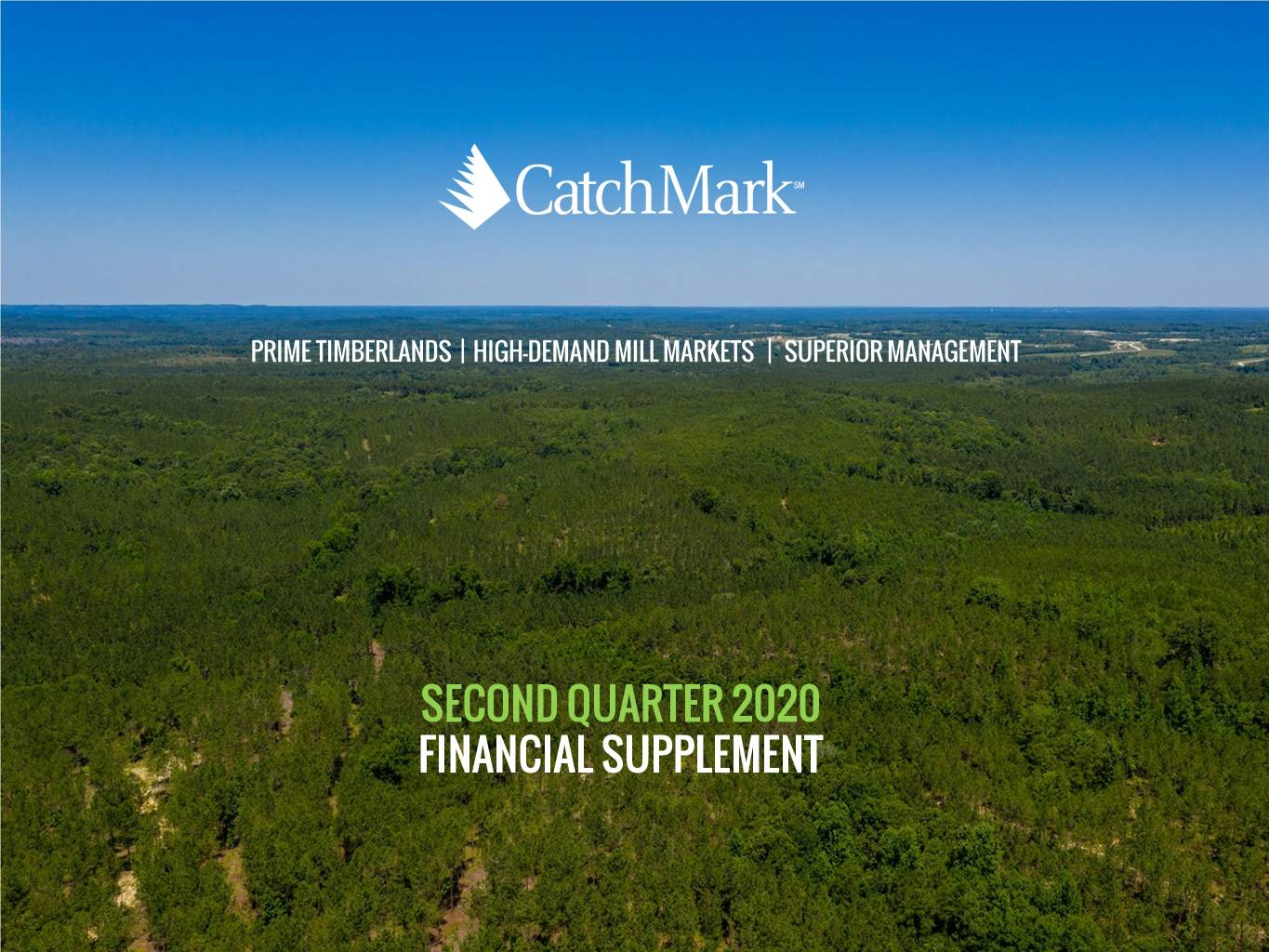
PRIME TIMBERLANDS | HIGH-DEMAND MILL MARKETS | SUPERIOR MANAGEMENT SECOND QUARTER 2020 FINANCIAL SUPPLEMENT
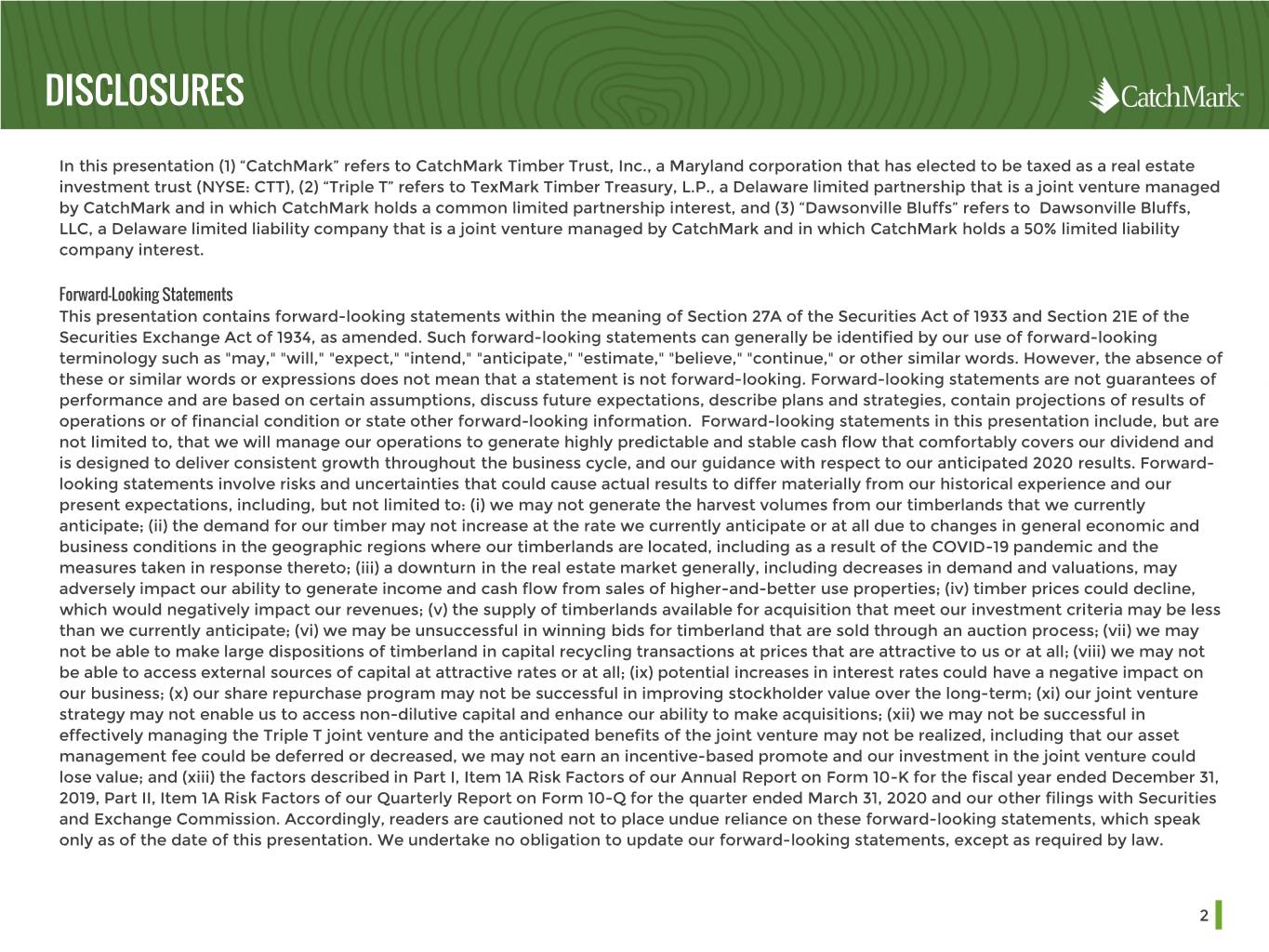
DISCLOSURES In this presentation (1) “CatchMark” refers to CatchMark Timber Trust, Inc., a Maryland corporation that has elected to be taxed as a real estate investment trust (NYSE: CTT), (2) “Triple T” refers to TexMark Timber Treasury, L.P., a Delaware limited partnership that is a joint venture managed by CatchMark and in which CatchMark holds a common limited partnership interest, and (3) “Dawsonville Bluffs” refers to Dawsonville Bluffs, LLC, a Delaware limited liability company that is a joint venture managed by CatchMark and in which CatchMark holds a 50% limited liability company interest. Forward-Looking Statements This presentation contains forward-looking statements within the meaning of Section 27A of the Securities Act of 1933 and Section 21E of the Securities Exchange Act of 1934, as amended. Such forward-looking statements can generally be identified by our use of forward-looking terminology such as "may," "will," "expect," "intend," "anticipate," "estimate," "believe," "continue," or other similar words. However, the absence of these or similar words or expressions does not mean that a statement is not forward-looking. Forward-looking statements are not guarantees of performance and are based on certain assumptions, discuss future expectations, describe plans and strategies, contain projections of results of operations or of financial condition or state other forward-looking information. Forward-looking statements in this presentation include, but are not limited to, that we will manage our operations to generate highly predictable and stable cash flow that comfortably covers our dividend and is designed to deliver consistent growth throughout the business cycle, and our guidance with respect to our anticipated 2020 results. Forward- looking statements involve risks and uncertainties that could cause actual results to differ materially from our historical experience and our present expectations, including, but not limited to: (i) we may not generate the harvest volumes from our timberlands that we currently anticipate; (ii) the demand for our timber may not increase at the rate we currently anticipate or at all due to changes in general economic and business conditions in the geographic regions where our timberlands are located, including as a result of the COVID-19 pandemic and the measures taken in response thereto; (iii) a downturn in the real estate market generally, including decreases in demand and valuations, may adversely impact our ability to generate income and cash flow from sales of higher-and-better use properties; (iv) timber prices could decline, which would negatively impact our revenues; (v) the supply of timberlands available for acquisition that meet our investment criteria may be less than we currently anticipate; (vi) we may be unsuccessful in winning bids for timberland that are sold through an auction process; (vii) we may not be able to make large dispositions of timberland in capital recycling transactions at prices that are attractive to us or at all; (viii) we may not be able to access external sources of capital at attractive rates or at all; (ix) potential increases in interest rates could have a negative impact on our business; (x) our share repurchase program may not be successful in improving stockholder value over the long-term; (xi) our joint venture strategy may not enable us to access non-dilutive capital and enhance our ability to make acquisitions; (xii) we may not be successful in effectively managing the Triple T joint venture and the anticipated benefits of the joint venture may not be realized, including that our asset management fee could be deferred or decreased, we may not earn an incentive-based promote and our investment in the joint venture could lose value; and (xiii) the factors described in Part I, Item 1A Risk Factors of our Annual Report on Form 10-K for the fiscal year ended December 31, 2019, Part II, Item 1A Risk Factors of our Quarterly Report on Form 10-Q for the quarter ended March 31, 2020 and our other filings with Securities and Exchange Commission. Accordingly, readers are cautioned not to place undue reliance on these forward-looking statements, which speak only as of the date of this presentation. We undertake no obligation to update our forward-looking statements, except as required by law. 2

STRATEGIES PRODUCE STABLE, VISIBLE, HIGH-QUALITY CASH FLOW CatchMark acquires prime timberlands in high-demand mill markets and manages operations to generate highly-predictable and stable cash flow that comfortably covers its dividend and is designed to deliver consistent growth throughout the business cycle. PRIME QUALITY HIGH-DEMAND SUPERIORMANAGEMENT PREDICATABLE TIMBERLANDS MILL MARKETS CASH FLOW GROWTH DISCIPLINED ACQUISITIONS OF PRIME HIGH-DEMAND MILL MARKETS SUPERIOR MANAGEMENT TIMBERLANDS PROVIDES RELIABLE OUTLET FOR MAXIMIZES CASH FLOWS PRODUCES DURABLE REVENUE AVAILABLE MERCHANTABLE THROUGHOUT THE BUSINESS GROWTH INVENTORY CYCLE DRIVES STABLE AND PREDICTABLE CASH FLOW 3

FINANCIAL AND OPERATING INFORMATION 4

FINANCIAL HIGHLIGHTS (in thousands, except per-share data) Results of Operations Q2 2020 Q1 2020 Q2 2019 2020 YTD 2019 YTD Revenues $21,757 $26,972 $28,660 $48,729 $51,233 Loss before unconsolidated joint ventures and income taxes $(3,838) $(4,161) $(1,914) $(7,999) $(5,000) Net loss $(6,183) $(4,249) $(30,565) $(10,432) $(60,960) Net loss per share – basic and diluted $(0.13) $(0.09) $(0.62) $(0.21) $(1.24) Adjusted EBITDA1 $9,435 $12,889 15,087 $22,324 $25,249 Weighted-average common shares outstanding - basic and diluted 48,744 48,989 49,076 48,866 49,069 Capital Resources and Liquidity Q2 2020 Q1 2020 Q2 2019 2020 YTD 2019 YTD Cash provided by operating activities $8,771 $11,259 $11,958 $20,030 $17,205 Cash provided by (used in) investing activities $(6,054) $18,551 4,424 $12,497 $3,961 Cash used in financing activities $(3,779) $(30,885) $(7,985) $(34,664) $(15,963) Cash Available for Distribution (CAD)4 $5,409 $7,415 $9,805 $12,824 $14,737 6/30/2020 12/31/2019 Debt2 $442,705 $458,555 (-) Cash (9,350) (11,487) Net Debt $433,355 $447,068 Net Debt/Adjusted EBITDA1 8.0x 7.9x Net Debt/Enterprise Value3 50% 44% Cash $9,350 $11,487 Credit Facilities Capacity Revolving line of credit $35,000 $35,000 Acquisition facility 115,914 150,064 $160,264 $196,551 1. Adjusted EBITDA is a non-GAAP measure. See Appendix for our definition of Adjusted EBITDA and reconciliation of net income (loss) to Adjusted EBITDA. 2. Debt is gross of deferred financing costs. 3. Enterprise value is based on equity market capitalization as of the last trading day of the respective period plus net debt. 4. Cash Available for Distribution is a non-GAAP measure. See Appendix for our definition of Cash Available for Distribution and slide 7 for a reconciliation of Cash Provided by Operating Activities to Cash Available for 5 Distribution.
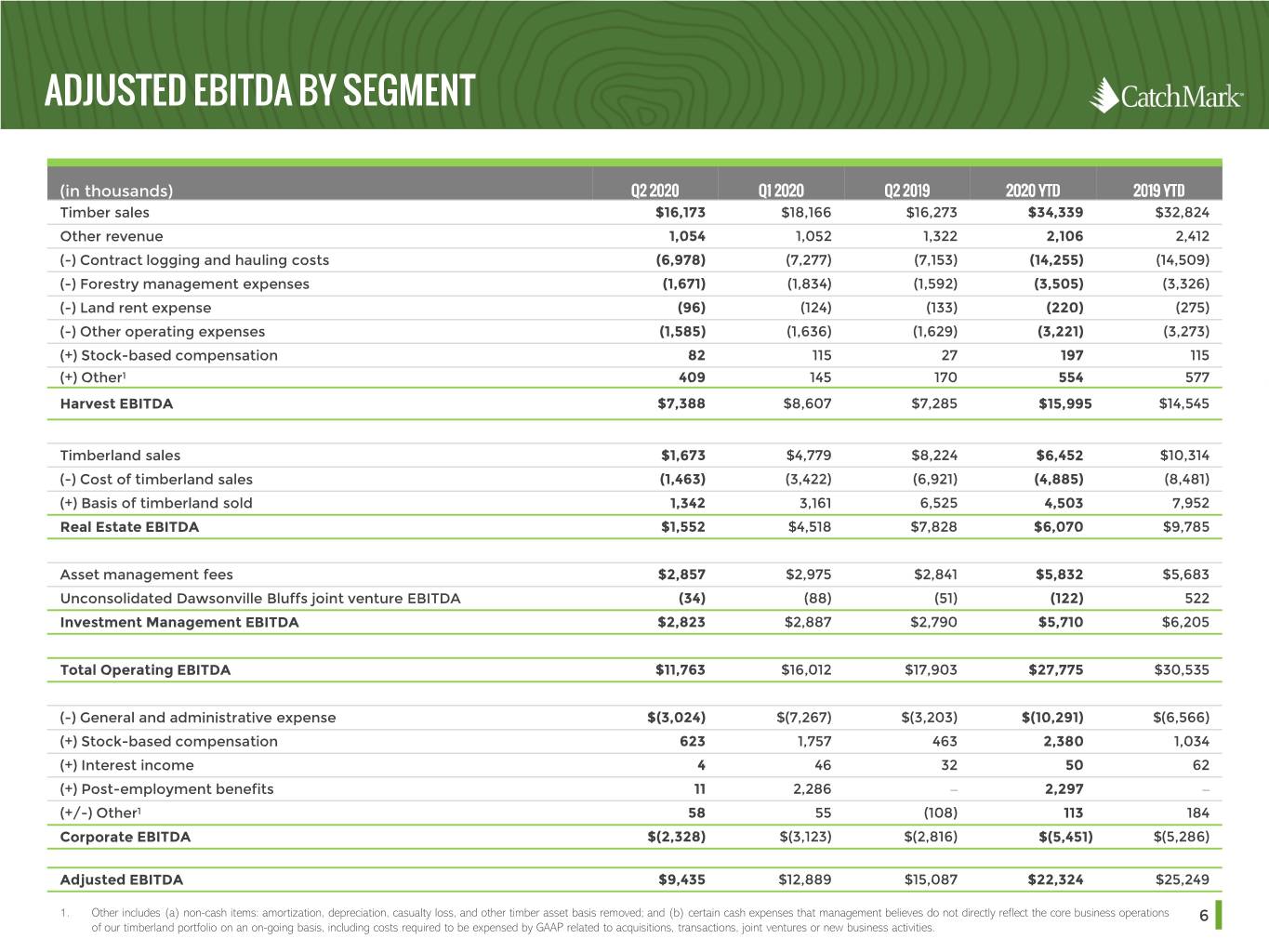
ADJUSTED EBITDA BY SEGMENT (in thousands) Q2 2020 Q1 2020 Q2 2019 2020 YTD 2019 YTD Timber sales $16,173 $18,166 $16,273 $34,339 $32,824 Other revenue 1,054 1,052 1,322 2,106 2,412 (-) Contract logging and hauling costs (6,978) (7,277) (7,153) (14,255) (14,509) (-) Forestry management expenses (1,671) (1,834) (1,592) (3,505) (3,326) (-) Land rent expense (96) (124) (133) (220) (275) (-) Other operating expenses (1,585) (1,636) (1,629) (3,221) (3,273) (+) Stock-based compensation 82 115 27 197 115 (+) Other1 409 145 170 554 577 Harvest EBITDA $7,388 $8,607 $7,285 $15,995 $14,545 Timberland sales $1,673 $4,779 $8,224 $6,452 $10,314 (-) Cost of timberland sales (1,463) (3,422) (6,921) (4,885) (8,481) (+) Basis of timberland sold 1,342 3,161 6,525 4,503 7,952 Real Estate EBITDA $1,552 $4,518 $7,828 $6,070 $9,785 Asset management fees $2,857 $2,975 $2,841 $5,832 $5,683 Unconsolidated Dawsonville Bluffs joint venture EBITDA (34) (88) (51) (122) 522 Investment Management EBITDA $2,823 $2,887 $2,790 $5,710 $6,205 Total Operating EBITDA $11,763 $16,012 $17,903 $27,775 $30,535 (-) General and administrative expense $(3,024) $(7,267) $(3,203) $(10,291) $(6,566) (+) Stock-based compensation 623 1,757 463 2,380 1,034 (+) Interest income 4 46 32 50 62 (+) Post-employment benefits 11 2,286 _ 2,297 _ (+/-) Other1 58 55 (108) 113 184 Corporate EBITDA $(2,328) $(3,123) $(2,816) $(5,451) $(5,286) Adjusted EBITDA $9,435 $12,889 $15,087 $22,324 $25,249 1. Other includes (a) non-cash items: amortization, depreciation, casualty loss, and other timber asset basis removed; and (b) certain cash expenses that management believes do not directly reflect the core business operations 6 of our timberland portfolio on an on-going basis, including costs required to be expensed by GAAP related to acquisitions, transactions, joint ventures or new business activities.
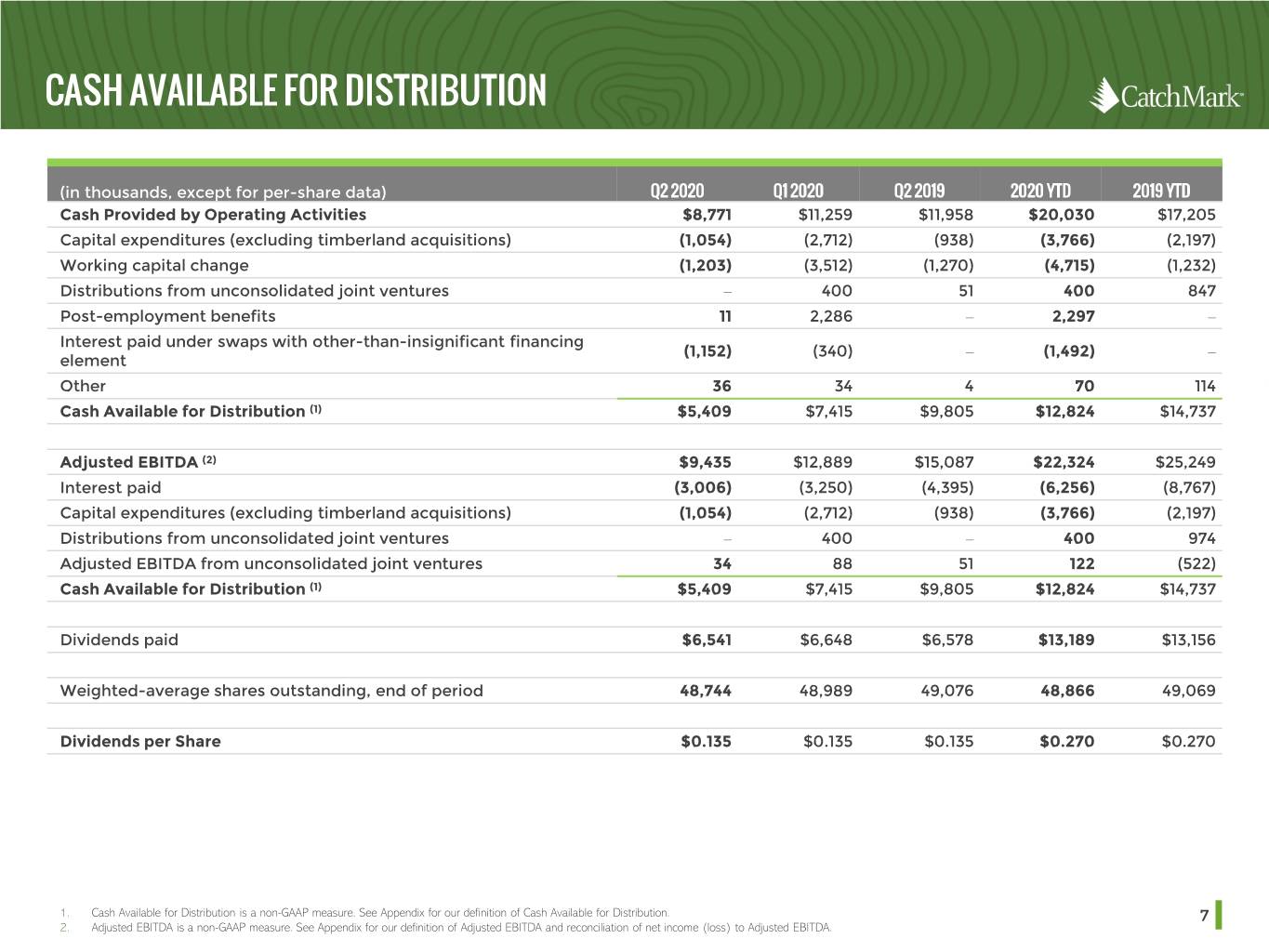
CASH AVAILABLE FOR DISTRIBUTION (in thousands, except for per-share data) Q2 2020 Q1 2020 Q2 2019 2020 YTD 2019 YTD Cash Provided by Operating Activities $8,771 $11,259 $11,958 $20,030 $17,205 Capital expenditures (excluding timberland acquisitions) (1,054) (2,712) (938) (3,766) (2,197) Working capital change (1,203) (3,512) (1,270) (4,715) (1,232) Distributions from unconsolidated joint ventures _ 400 51 400 847 Post-employment benefits 11 2,286 _ 2,297 _ Interest paid under swaps with other-than-insignificant financing (1,152) (340) _ (1,492) _ element Other 36 34 4 70 114 Cash Available for Distribution (1) $5,409 $7,415 $9,805 $12,824 $14,737 Adjusted EBITDA (2) $9,435 $12,889 $15,087 $22,324 $25,249 Interest paid (3,006) (3,250) (4,395) (6,256) (8,767) Capital expenditures (excluding timberland acquisitions) (1,054) (2,712) (938) (3,766) (2,197) Distributions from unconsolidated joint ventures _ 400 _ 400 974 Adjusted EBITDA from unconsolidated joint ventures 34 88 51 122 (522) Cash Available for Distribution (1) $5,409 $7,415 $9,805 $12,824 $14,737 Dividends paid $6,541 $6,648 $6,578 $13,189 $13,156 Weighted-average shares outstanding, end of period 48,744 48,989 49,076 48,866 49,069 Dividends per Share $0.135 $0.135 $0.135 $0.270 $0.270 1. Cash Available for Distribution is a non-GAAP measure. See Appendix for our definition of Cash Available for Distribution. 7 2. Adjusted EBITDA is a non-GAAP measure. See Appendix for our definition of Adjusted EBITDA and reconciliation of net income (loss) to Adjusted EBITDA.

U.S. SOUTH TIMBER OVERVIEW 2019 2020 1Q 2Q 3Q 4Q FY 1Q 2Q YTD Timber Sales Volume ('000 tons) Pulpwood 294 303 373 332 1,302 320 352 672 Sawtimber 188 177 237 271 873 250 195 445 Total 482 480 610 603 2,175 570 547 1,117 Delivered vs. Stumpage Delivered % as of total volume 79% 74% 64% 67% 71% 63% 61% 62% Stumpage % as of total volume 21% 26% 36% 33% 29% 37% 39% 38% Net Timber Sales Price ($ per ton) Pulpwood $15 $14 $14 $13 $14 $13 $12 $13 Sawtimber $24 $24 $24 $23 $24 $23 $23 $23 Sold Under Timber Supply Agreements Volume 130 162 149 150 591 103 120 223 % of total volume 27% 34% 24% 25% 27% 18% 22% 20% Summary Financial Data ($ in '000s) Timber sales $16,079 15,044 17,880 18,228 $67,231 $16,272 $14,565 $30,837 (-) Contract logging and hauling costs (7,152) (6,579) (7,092) (7,485) (28,308) (6,309) (5,967) (12,276) Net timber sales $8,927 $8,465 $10,788 $10,743 $38,923 $9,963 8,598 18,561 Other revenues 1,090 1,322 974 1,246 4,632 1,052 1,051 2,103 Total net timber sales and other revenues $10,017 $9,787 $11,762 $11,989 $43,555 $11,015 9,649 20,664 Period-end Acres Fee 414 406 395 392 392 375 374 374 Lease 27 26 26 25 25 22 22 22 Wholly-owned total 441 432 421 417 417 397 396 396 Joint venture interest 1,104 1,100 1,094 1,092 1,092 1,092 1,092 1,092 Total 1,545 1,532 1,515 1,509 1,509 1,489 1,488 1,488 8
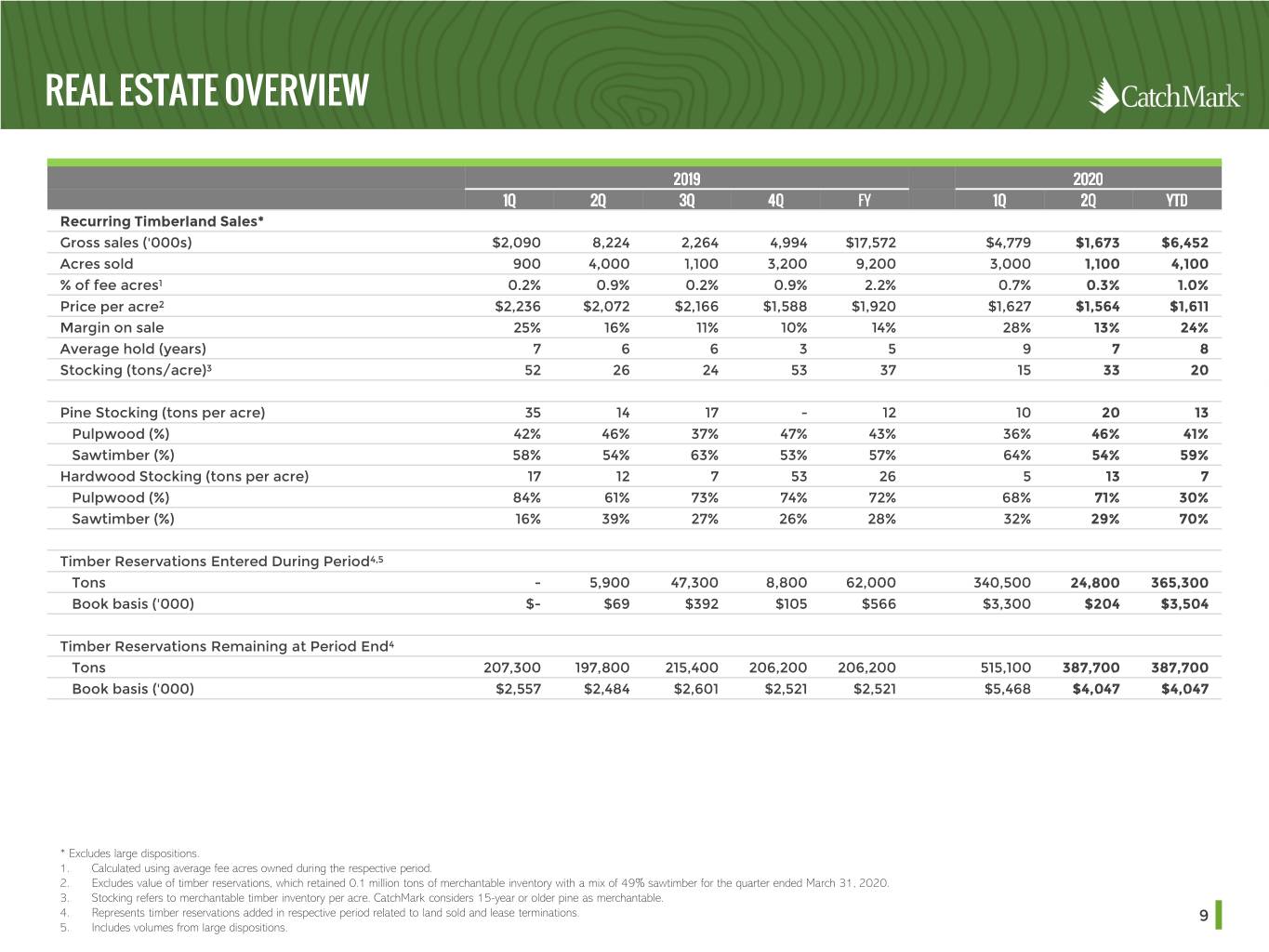
REAL ESTATE OVERVIEW 2019 2020 1Q 2Q 3Q 4Q FY 1Q 2Q YTD Recurring Timberland Sales* Gross sales ('000s) $2,090 8,224 2,264 4,994 $17,572 $4,779 $1,673 $6,452 Acres sold 900 4,000 1,100 3,200 9,200 3,000 1,100 4,100 % of fee acres1 0.2% 0.9% 0.2% 0.9% 2.2% 0.7% 0.3% 1.0% Price per acre2 $2,236 $2,072 $2,166 $1,588 $1,920 $1,627 $1,564 $1,611 Margin on sale 25% 16% 11% 10% 14% 28% 13% 24% Average hold (years) 7 6 6 3 5 9 7 8 Stocking (tons/acre)3 52 26 24 53 37 15 33 20 Pine Stocking (tons per acre) 35 14 17 - 12 10 20 13 Pulpwood (%) 42% 46% 37% 47% 43% 36% 46% 41% Sawtimber (%) 58% 54% 63% 53% 57% 64% 54% 59% Hardwood Stocking (tons per acre) 17 12 7 53 26 5 13 7 Pulpwood (%) 84% 61% 73% 74% 72% 68% 71% 30% Sawtimber (%) 16% 39% 27% 26% 28% 32% 29% 70% Timber Reservations Entered During Period4,5 Tons - 5,900 47,300 8,800 62,000 340,500 24,800 365,300 Book basis ('000) $- $69 $392 $105 $566 $3,300 $204 $3,504 Timber Reservations Remaining at Period End4 Tons 207,300 197,800 215,400 206,200 206,200 515,100 387,700 387,700 Book basis ('000) $2,557 $2,484 $2,601 $2,521 $2,521 $5,468 $4,047 $4,047 * Excludes large dispositions. 1. Calculated using average fee acres owned during the respective period. 2. Excludes value of timber reservations, which retained 0.1 million tons of merchantable inventory with a mix of 49% sawtimber for the quarter ended March 31, 2020. 3. Stocking refers to merchantable timber inventory per acre. CatchMark considers 15-year or older pine as merchantable. 4. Represents timber reservations added in respective period related to land sold and lease terminations. 9 5. Includes volumes from large dispositions.

SOLID CAPITAL POSITION Credit Metrics Credit Facilities and Maturity Schedule Fixed charge coverage ratio1 4.6x Total Credit Facilities of $593.6 Million Weighted-Average Life of Outstanding Debt is 5.6 Years Net Debt2/Adjusted EBITDA3,4 8.0x Net Debt2/Enterprise value5 50% Millions Debt Available Outstanding $250 Weighted average cost of debt6 2.43% Interest rate mix 7 Fixed: 62% / Floating: 38% $200 No debt maturities until late 2024. Allocation of Capital $150M Well-laddered $100M Investments Dividends Share Repurchases CAPEX $ Millions maturity schedule: Acquisition Term Loan $330 No more than 24% of Facility 1% 1% total outstanding $140M $300 8% $150 balance due in any Term Loan one year. $270 $115.9M $100M 6% $240 Term Loan $210 $100 $68.6M $180 Term 2% 2% Loan $150 12% 90% $120 94% 3% $50 6% 6% $35M LOC $34.1M $90 19% 1.5% 83% 23.5% $60 72% 69% 12% $30 9% 15% $0 $0 $0 73% 12% 53% $0 6% 20% $0 2014 2015 2016 2017 2018 2019 Q2 '20 YTD 2020 2021 2022 2023 2024 2025 2026 2027 1. Calculated using trailing twelve-month Adjusted EBITDA divided by trailing twelve-month cash paid for interest as of 6/30/2020. 2. Net debt equals outstanding borrowings net of cash on hand as of 6/30/2020. 3. Trailing twelve-month Adjusted EBITDA as of 6/30/2020. 4. Adjusted EBITDA is a non-GAAP measure. See Appendix for our definition of Adjusted EBITDA and reconciliation of net income (loss) to Adjusted EBITDA. 5. Enterprise value is based on equity market capitalization plus net debt as of 6/30/2020. 6. After consideration of effects of interest rate swaps and patronage refund, as of 6/30/2020. 10 7. As of 6/30/2020.
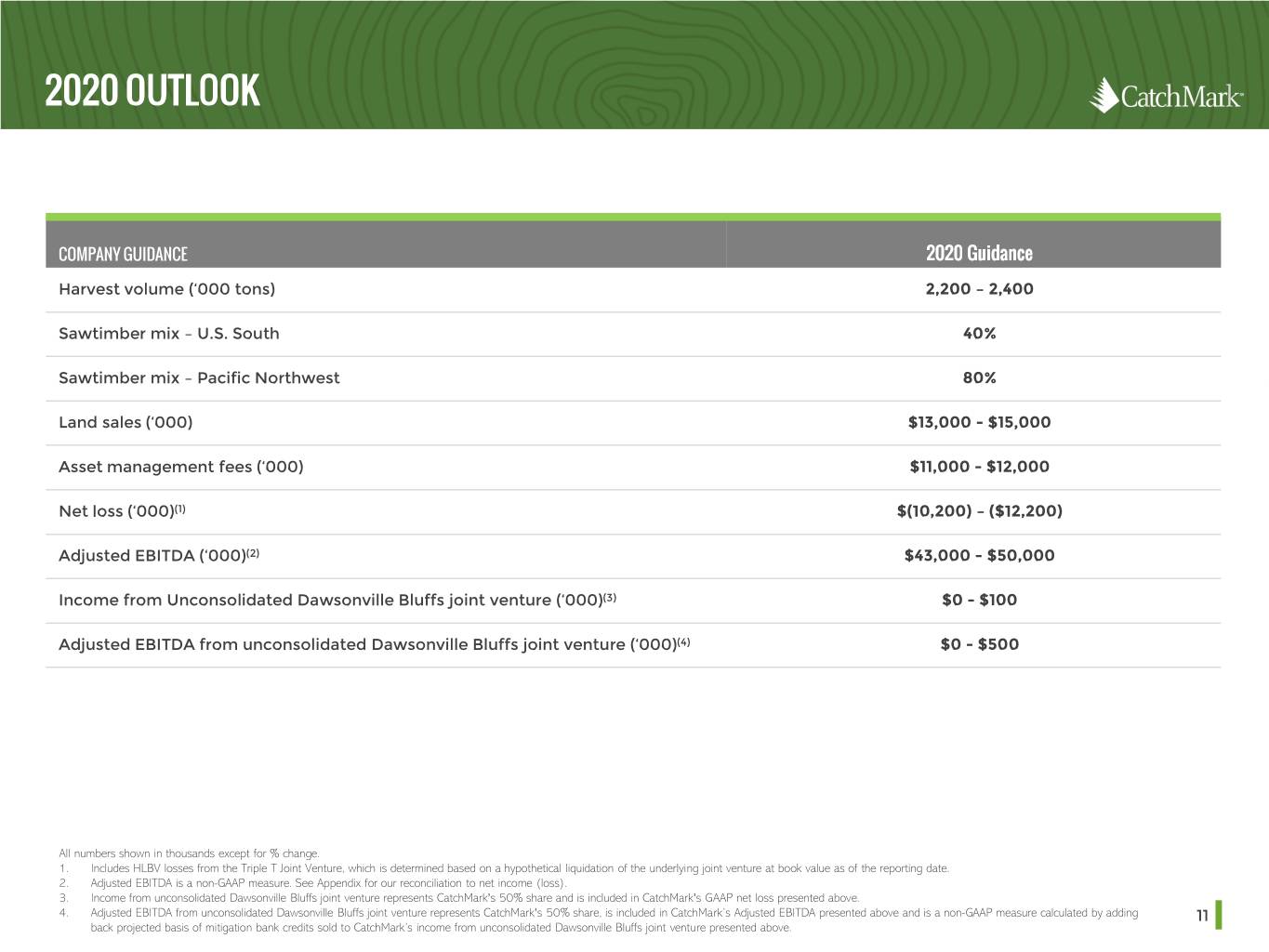
2020 OUTLOOK COMPANY GUIDANCE 2020 Guidance Harvest volume (‘000 tons) 2,200 – 2,400 Sawtimber mix – U.S. South 40% Sawtimber mix – Pacific Northwest 80% Land sales (‘000) $13,000 - $15,000 Asset management fees (‘000) $11,000 - $12,000 Net loss (‘000)(1) $(10,200) – ($12,200) Adjusted EBITDA (‘000)(2) $43,000 - $50,000 Income from Unconsolidated Dawsonville Bluffs joint venture (‘000)(3) $0 - $100 Adjusted EBITDA from unconsolidated Dawsonville Bluffs joint venture (‘000)(4) $0 - $500 All numbers shown in thousands except for % change. 1. Includes HLBV losses from the Triple T Joint Venture, which is determined based on a hypothetical liquidation of the underlying joint venture at book value as of the reporting date. 2. Adjusted EBITDA is a non-GAAP measure. See Appendix for our reconciliation to net income (loss). 3. Income from unconsolidated Dawsonville Bluffs joint venture represents CatchMark's 50% share and is included in CatchMark's GAAP net loss presented above. 4. Adjusted EBITDA from unconsolidated Dawsonville Bluffs joint venture represents CatchMark's 50% share, is included in CatchMark’s Adjusted EBITDA presented above and is a non-GAAP measure calculated by adding 11 back projected basis of mitigation bank credits sold to CatchMark’s income from unconsolidated Dawsonville Bluffs joint venture presented above.

APPENDIX 12
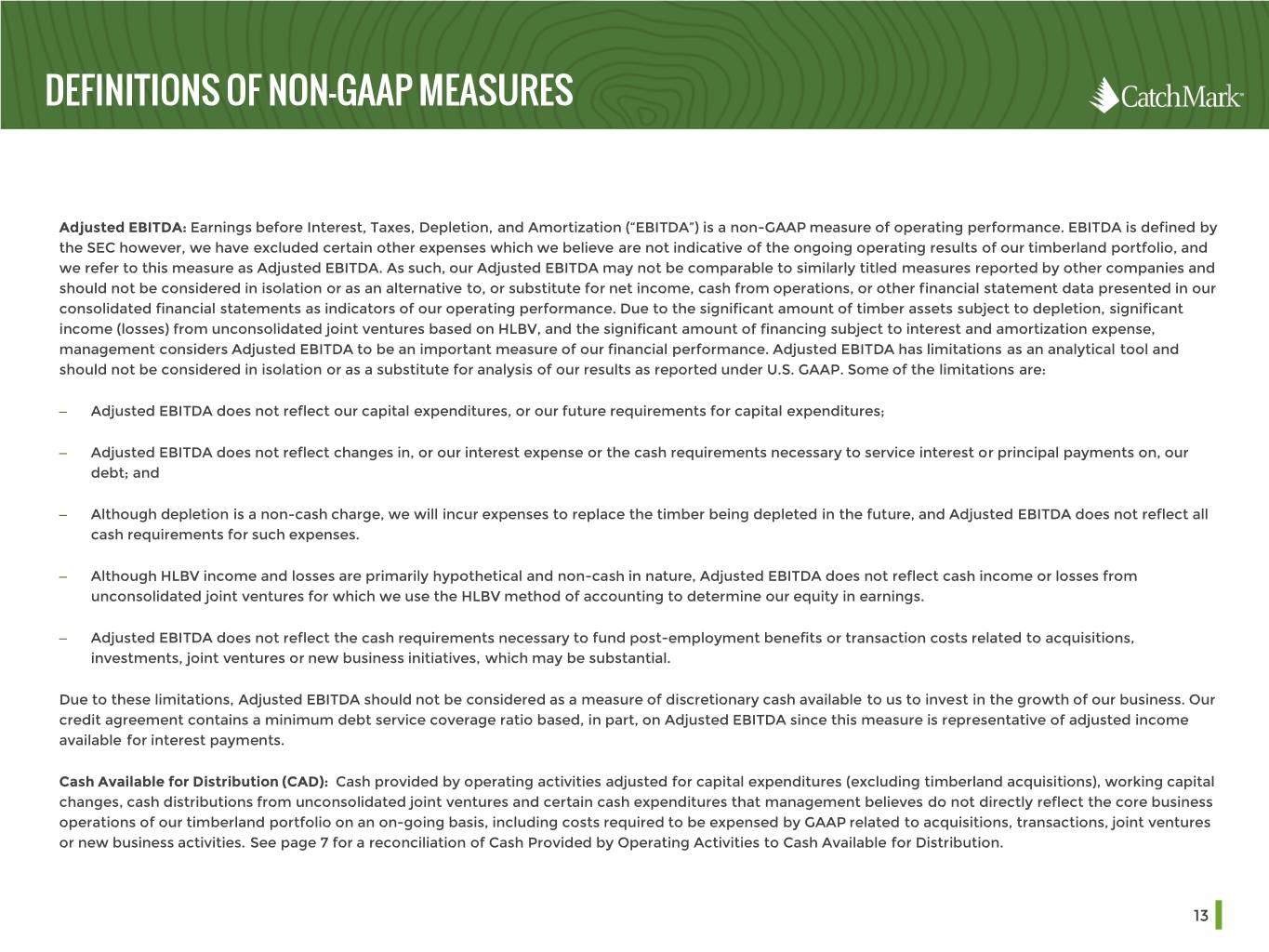
DEFINITIONS OF NON-GAAP MEASURES Adjusted EBITDA: Earnings before Interest, Taxes, Depletion, and Amortization (“EBITDA”) is a non-GAAP measure of operating performance. EBITDA is defined by the SEC however, we have excluded certain other expenses which we believe are not indicative of the ongoing operating results of our timberland portfolio, and we refer to this measure as Adjusted EBITDA. As such, our Adjusted EBITDA may not be comparable to similarly titled measures reported by other companies and should not be considered in isolation or as an alternative to, or substitute for net income, cash from operations, or other financial statement data presented in our consolidated financial statements as indicators of our operating performance. Due to the significant amount of timber assets subject to depletion, significant income (losses) from unconsolidated joint ventures based on HLBV, and the significant amount of financing subject to interest and amortization expense, management considers Adjusted EBITDA to be an important measure of our financial performance. Adjusted EBITDA has limitations as an analytical tool and should not be considered in isolation or as a substitute for analysis of our results as reported under U.S. GAAP. Some of the limitations are: ‒ Adjusted EBITDA does not reflect our capital expenditures, or our future requirements for capital expenditures; ‒ Adjusted EBITDA does not reflect changes in, or our interest expense or the cash requirements necessary to service interest or principal payments on, our debt; and ‒ Although depletion is a non-cash charge, we will incur expenses to replace the timber being depleted in the future, and Adjusted EBITDA does not reflect all cash requirements for such expenses. ‒ Although HLBV income and losses are primarily hypothetical and non-cash in nature, Adjusted EBITDA does not reflect cash income or losses from unconsolidated joint ventures for which we use the HLBV method of accounting to determine our equity in earnings. ‒ Adjusted EBITDA does not reflect the cash requirements necessary to fund post-employment benefits or transaction costs related to acquisitions, investments, joint ventures or new business initiatives, which may be substantial. Due to these limitations, Adjusted EBITDA should not be considered as a measure of discretionary cash available to us to invest in the growth of our business. Our credit agreement contains a minimum debt service coverage ratio based, in part, on Adjusted EBITDA since this measure is representative of adjusted income available for interest payments. Cash Available for Distribution (CAD): Cash provided by operating activities adjusted for capital expenditures (excluding timberland acquisitions), working capital changes, cash distributions from unconsolidated joint ventures and certain cash expenditures that management believes do not directly reflect the core business operations of our timberland portfolio on an on-going basis, including costs required to be expensed by GAAP related to acquisitions, transactions, joint ventures or new business activities. See page 7 for a reconciliation of Cash Provided by Operating Activities to Cash Available for Distribution. 13
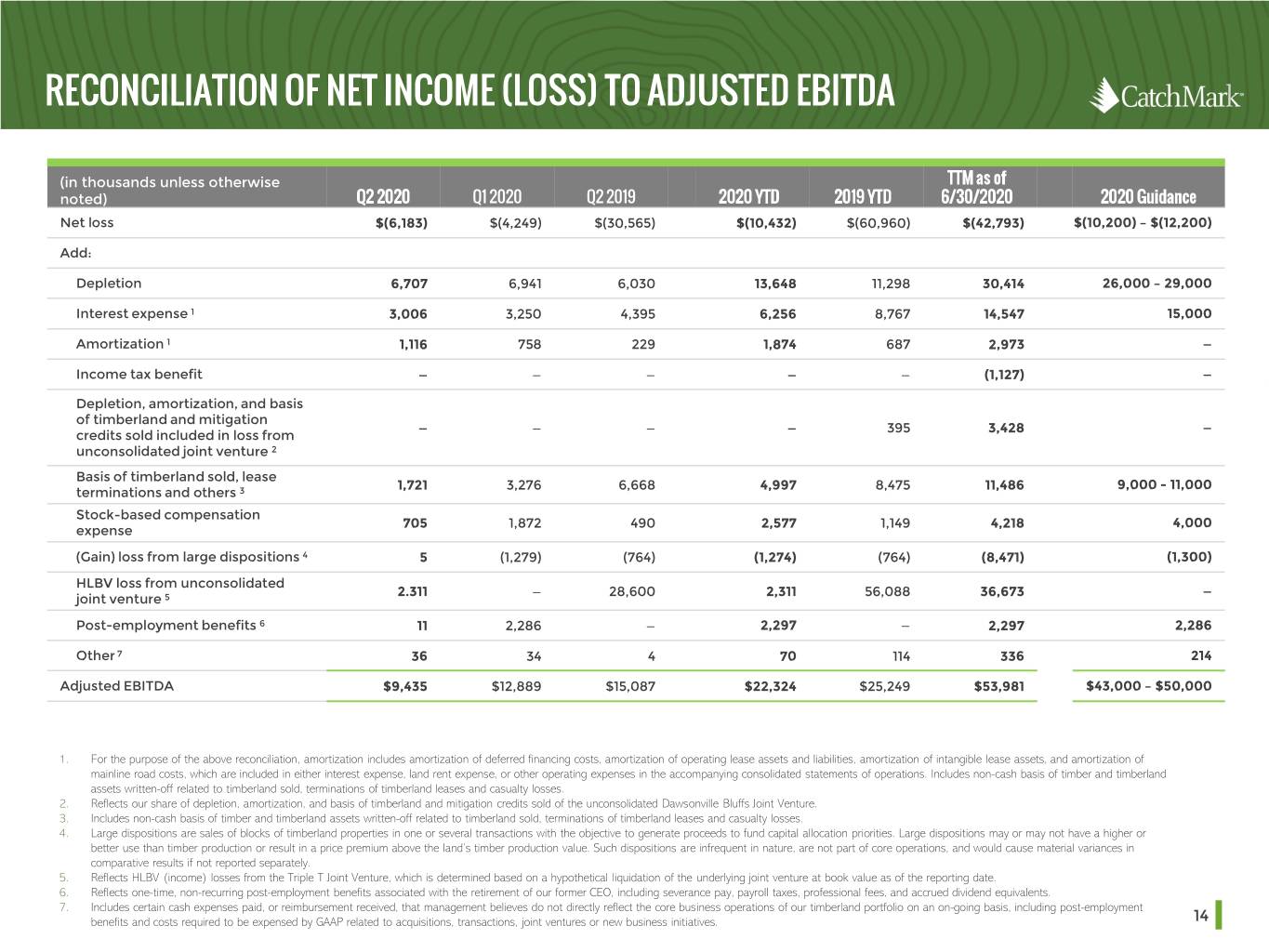
RECONCILIATION OF NET INCOME (LOSS) TO ADJUSTED EBITDA (in thousands unless otherwise TTM as of noted) Q2 2020 Q1 2020 Q2 2019 2020 YTD 2019 YTD 6/30/2020 2020 Guidance Net loss $(6,183) $(4,249) $(30,565) $(10,432) $(60,960) $(42,793) $(10,200) – $(12,200) Add: Depletion 6,707 6,941 6,030 13,648 11,298 30,414 26,000 – 29,000 Interest expense 1 3,006 3,250 4,395 6,256 8,767 14,547 15,000 Amortization 1 1,116 758 229 1,874 687 2,973 — Income tax benefit — — — — — (1,127) — Depletion, amortization, and basis of timberland and mitigation — — — — 395 3,428 — credits sold included in loss from unconsolidated joint venture 2 Basis of timberland sold, lease 1,721 3,276 6,668 4,997 8,475 11,486 9,000 - 11,000 terminations and others 3 Stock-based compensation 705 1,872 490 2,577 1,149 4,218 4,000 expense (Gain) loss from large dispositions 4 5 (1,279) (764) (1,274) (764) (8,471) (1,300) HLBV loss from unconsolidated 2.311 — 28,600 2,311 56,088 36,673 — joint venture 5 Post-employment benefits 6 11 2,286 — 2,297 — 2,297 2,286 Other 7 36 34 4 70 114 336 214 Adjusted EBITDA $9,435 $12,889 $15,087 $22,324 $25,249 $53,981 $43,000 – $50,000 1. For the purpose of the above reconciliation, amortization includes amortization of deferred financing costs, amortization of operating lease assets and liabilities, amortization of intangible lease assets, and amortization of mainline road costs, which are included in either interest expense, land rent expense, or other operating expenses in the accompanying consolidated statements of operations. Includes non-cash basis of timber and timberland assets written-off related to timberland sold, terminations of timberland leases and casualty losses. 2. Reflects our share of depletion, amortization, and basis of timberland and mitigation credits sold of the unconsolidated Dawsonville Bluffs Joint Venture. 3. Includes non-cash basis of timber and timberland assets written-off related to timberland sold, terminations of timberland leases and casualty losses. 4. Large dispositions are sales of blocks of timberland properties in one or several transactions with the objective to generate proceeds to fund capital allocation priorities. Large dispositions may or may not have a higher or better use than timber production or result in a price premium above the land’s timber production value. Such dispositions are infrequent in nature, are not part of core operations, and would cause material variances in comparative results if not reported separately. 5. Reflects HLBV (income) losses from the Triple T Joint Venture, which is determined based on a hypothetical liquidation of the underlying joint venture at book value as of the reporting date. 6. Reflects one-time, non-recurring post-employment benefits associated with the retirement of our former CEO, including severance pay, payroll taxes, professional fees, and accrued dividend equivalents. 7. Includes certain cash expenses paid, or reimbursement received, that management believes do not directly reflect the core business operations of our timberland portfolio on an on-going basis, including post-employment benefits and costs required to be expensed by GAAP related to acquisitions, transactions, joint ventures or new business initiatives. 14
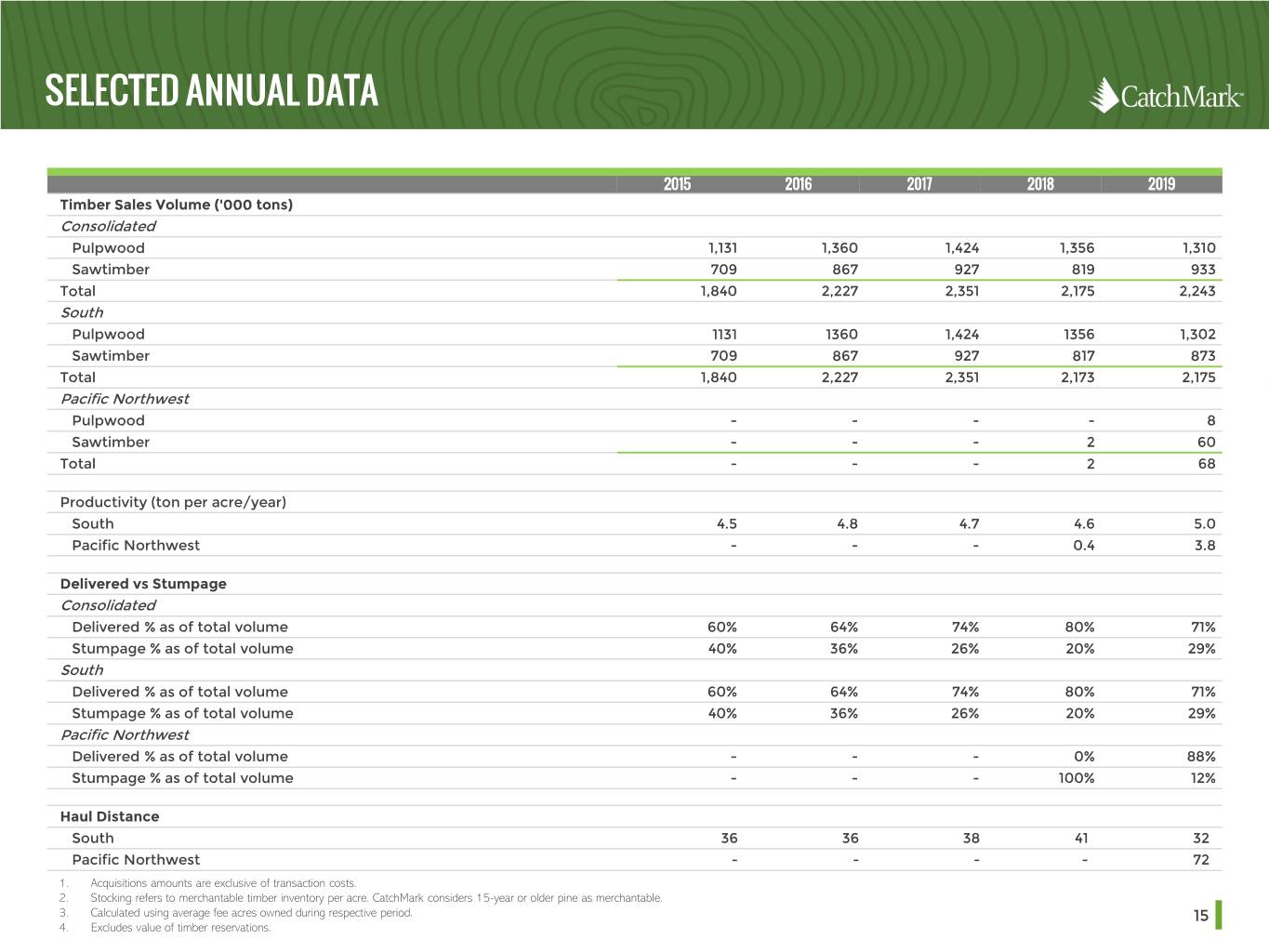
SELECTED ANNUAL DATA 2015 2016 2017 2018 2019 Timber Sales Volume ('000 tons) Consolidated Pulpwood 1,131 1,360 1,424 1,356 1,310 Sawtimber 709 867 927 819 933 Total 1,840 2,227 2,351 2,175 2,243 South Pulpwood 1131 1360 1,424 1356 1,302 Sawtimber 709 867 927 817 873 Total 1,840 2,227 2,351 2,173 2,175 Pacific Northwest Pulpwood - - - - 8 Sawtimber - - - 2 60 Total - - - 2 68 Productivity (ton per acre/year) South 4.5 4.8 4.7 4.6 5.0 Pacific Northwest - - - 0.4 3.8 Delivered vs Stumpage Consolidated Delivered % as of total volume 60% 64% 74% 80% 71% Stumpage % as of total volume 40% 36% 26% 20% 29% South Delivered % as of total volume 60% 64% 74% 80% 71% Stumpage % as of total volume 40% 36% 26% 20% 29% Pacific Northwest Delivered % as of total volume - - - 0% 88% Stumpage % as of total volume - - - 100% 12% Haul Distance South 36 36 38 41 32 Pacific Northwest - - - - 72 1. Acquisitions amounts are exclusive of transaction costs. 2. Stocking refers to merchantable timber inventory per acre. CatchMark considers 15-year or older pine as merchantable. 3. Calculated using average fee acres owned during respective period. 15 4. Excludes value of timber reservations.
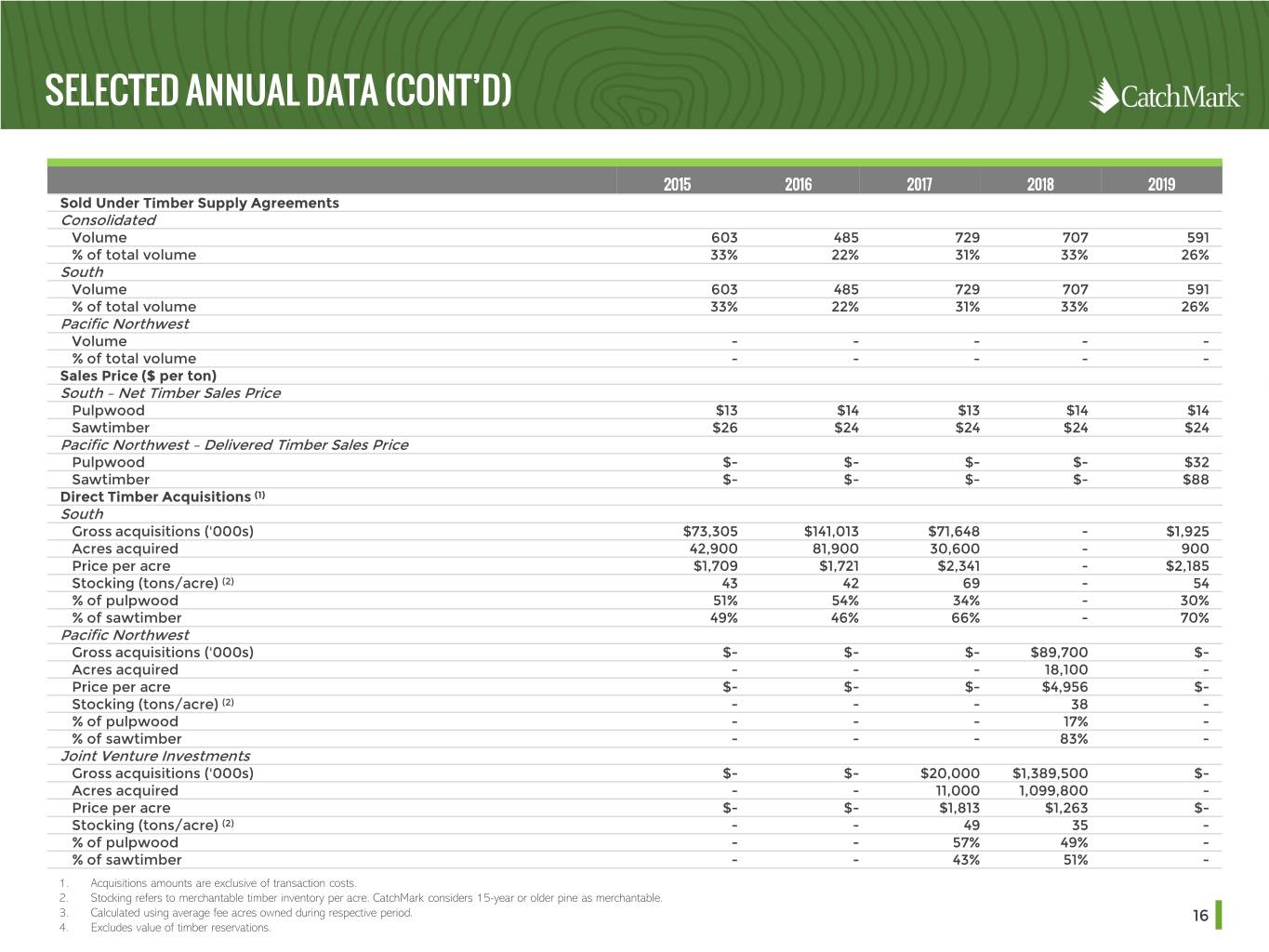
SELECTED ANNUAL DATA (CONT’D) 2015 2016 2017 2018 2019 Sold Under Timber Supply Agreements Consolidated Volume 603 485 729 707 591 % of total volume 33% 22% 31% 33% 26% South Volume 603 485 729 707 591 % of total volume 33% 22% 31% 33% 26% Pacific Northwest Volume - - - - - % of total volume - - - - - Sales Price ($ per ton) South – Net Timber Sales Price Pulpwood $13 $14 $13 $14 $14 Sawtimber $26 $24 $24 $24 $24 Pacific Northwest – Delivered Timber Sales Price Pulpwood $- $- $- $- $32 Sawtimber $- $- $- $- $88 Direct Timber Acquisitions (1) South Gross acquisitions ('000s) $73,305 $141,013 $71,648 - $1,925 Acres acquired 42,900 81,900 30,600 - 900 Price per acre $1,709 $1,721 $2,341 - $2,185 Stocking (tons/acre) (2) 43 42 69 - 54 % of pulpwood 51% 54% 34% - 30% % of sawtimber 49% 46% 66% - 70% Pacific Northwest Gross acquisitions ('000s) $- $- $- $89,700 $- Acres acquired - - - 18,100 - Price per acre $- $- $- $4,956 $- Stocking (tons/acre) (2) - - - 38 - % of pulpwood - - - 17% - % of sawtimber - - - 83% - Joint Venture Investments Gross acquisitions ('000s) $- $- $20,000 $1,389,500 $- Acres acquired - - 11,000 1,099,800 - Price per acre $- $- $1,813 $1,263 $- Stocking (tons/acre) (2) - - 49 35 - % of pulpwood - - 57% 49% - % of sawtimber - - 43% 51% - 1. Acquisitions amounts are exclusive of transaction costs. 2. Stocking refers to merchantable timber inventory per acre. CatchMark considers 15-year or older pine as merchantable. 3. Calculated using average fee acres owned during respective period. 16 4. Excludes value of timber reservations.
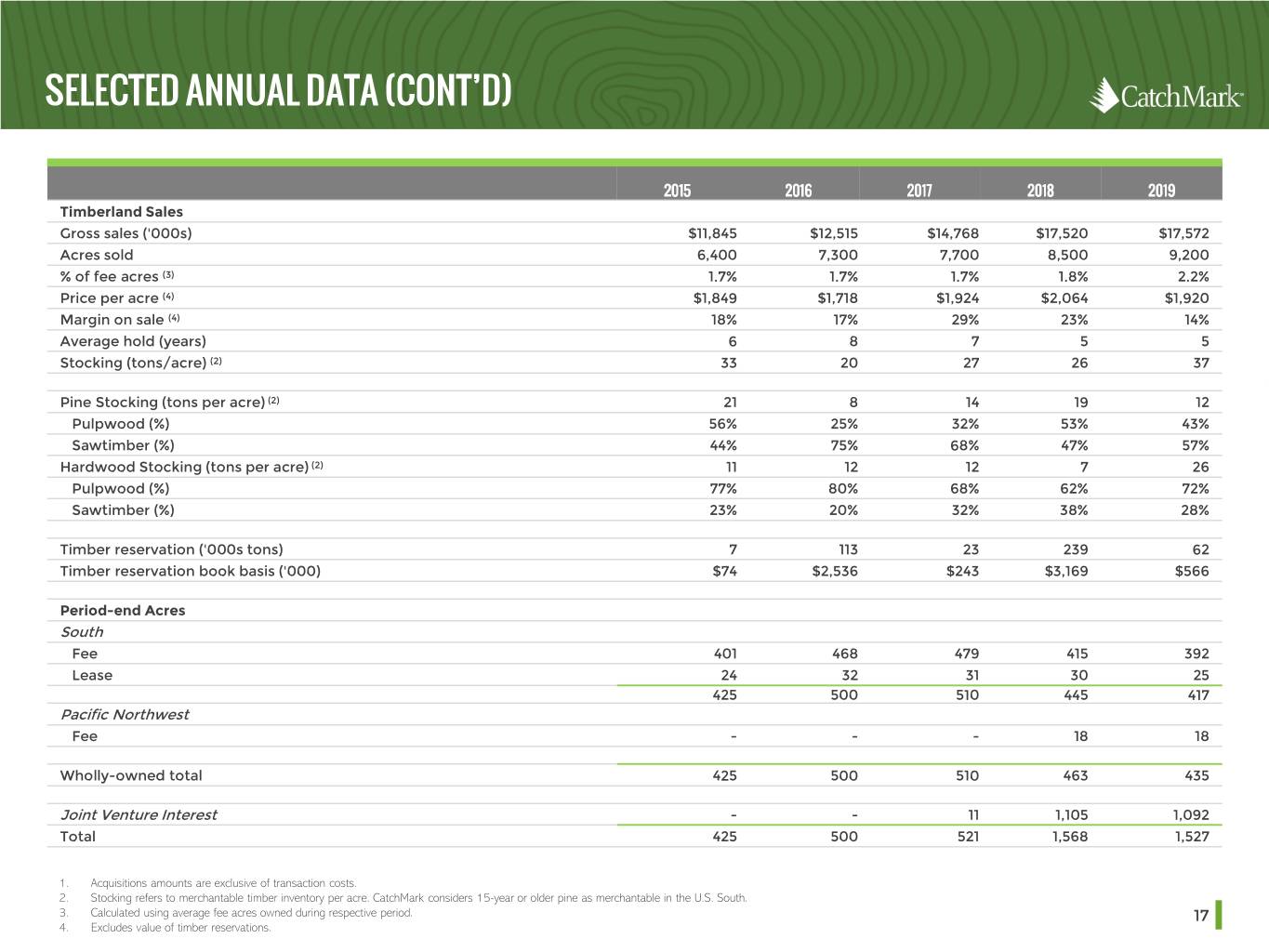
SELECTED ANNUAL DATA (CONT’D) 2015 2016 2017 2018 2019 Timberland Sales Gross sales ('000s) $11,845 $12,515 $14,768 $17,520 $17,572 Acres sold 6,400 7,300 7,700 8,500 9,200 % of fee acres (3) 1.7% 1.7% 1.7% 1.8% 2.2% Price per acre (4) $1,849 $1,718 $1,924 $2,064 $1,920 Margin on sale (4) 18% 17% 29% 23% 14% Average hold (years) 6 8 7 5 5 Stocking (tons/acre) (2) 33 20 27 26 37 Pine Stocking (tons per acre) (2) 21 8 14 19 12 Pulpwood (%) 56% 25% 32% 53% 43% Sawtimber (%) 44% 75% 68% 47% 57% Hardwood Stocking (tons per acre) (2) 11 12 12 7 26 Pulpwood (%) 77% 80% 68% 62% 72% Sawtimber (%) 23% 20% 32% 38% 28% Timber reservation ('000s tons) 7 113 23 239 62 Timber reservation book basis ('000) $74 $2,536 $243 $3,169 $566 Period-end Acres South Fee 401 468 479 415 392 Lease 24 32 31 30 25 425 500 510 445 417 Pacific Northwest Fee - - - 18 18 Wholly-owned total 425 500 510 463 435 Joint Venture Interest - - 11 1,105 1,092 Total 425 500 521 1,568 1,527 1. Acquisitions amounts are exclusive of transaction costs. 2. Stocking refers to merchantable timber inventory per acre. CatchMark considers 15-year or older pine as merchantable in the U.S. South. 3. Calculated using average fee acres owned during respective period. 17 4. Excludes value of timber reservations.

SELECTED ANNUAL DATA (CONT’D) 2015 2016 2017 2018 2019 Average Pine Planation Age – South 14 14 14 14 14 Average Site Index South 72 72 72 73 75 Pacific Northwest - - - 118 118 Period-end Merchantantable Timber Inventory ('000s) Volume ('000s tons) 16,773 20,309 21,206 19,751 18,184 Tons/acre 40 41 42 42 42 % sawtimber 48% 49% 49% 49% 52% NCREIF Average Value Per Acre South $1,777 $1,778 $1,781 $1,777 $1,810 Pacific Northwest $2,610 $2,621 $2,787 $2,936 $2,939 1. Acquisitions amounts are exclusive of transaction costs. 2. Stocking refers to merchantable timber inventory per acre. CatchMark considers 15-year or older pine as merchantable in the U.S. South. 3. Calculated using average fee acres owned during respective period. 18 4. Excludes value of timber reservations.
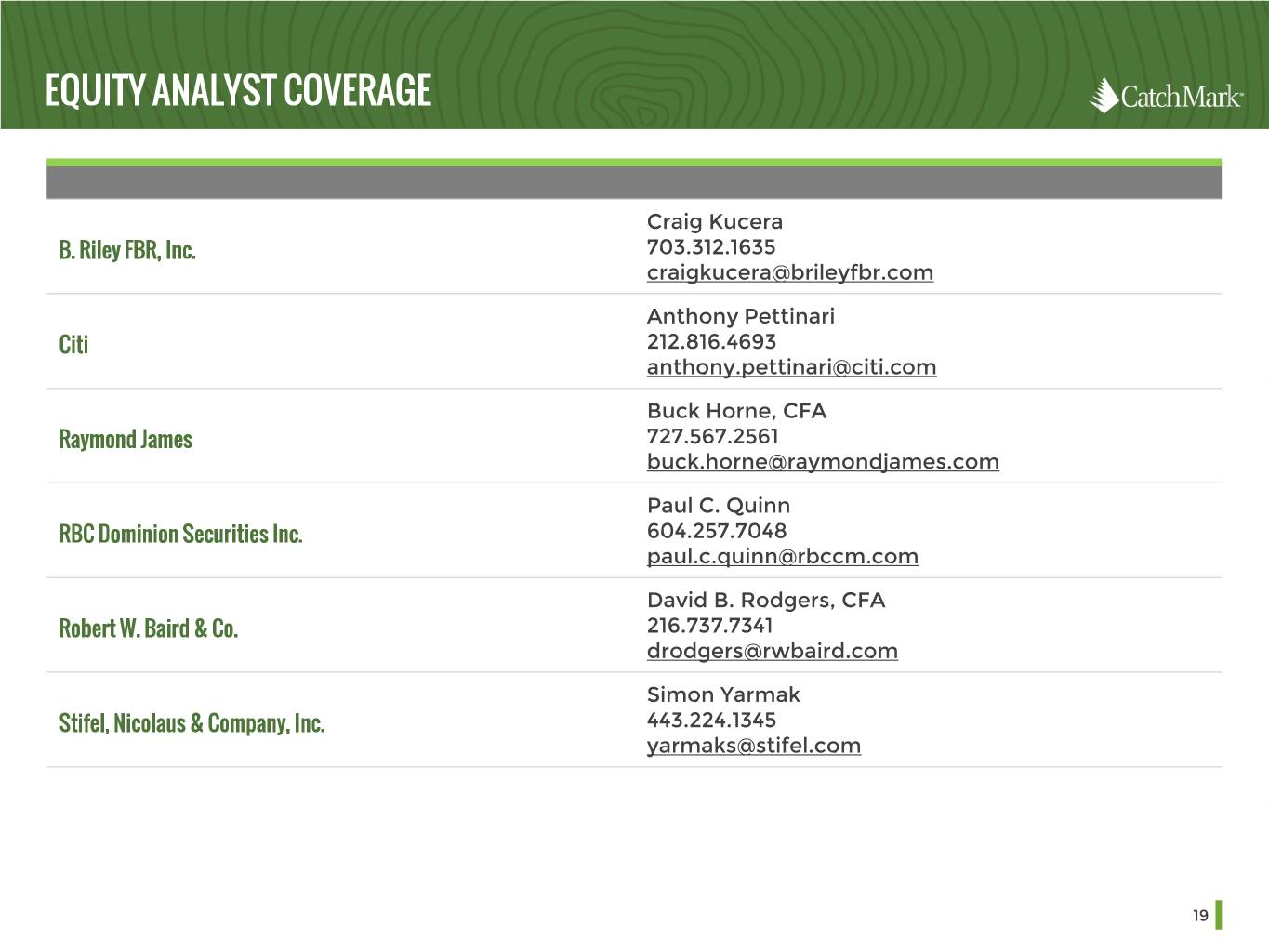
EQUITY ANALYST COVERAGE Craig Kucera B. Riley FBR, Inc. 703.312.1635 craigkucera@brileyfbr.com Anthony Pettinari Citi 212.816.4693 anthony.pettinari@citi.com Buck Horne, CFA Raymond James 727.567.2561 buck.horne@raymondjames.com Paul C. Quinn RBC Dominion Securities Inc. 604.257.7048 paul.c.quinn@rbccm.com David B. Rodgers, CFA Robert W. Baird & Co. 216.737.7341 drodgers@rwbaird.com Simon Yarmak Stifel, Nicolaus & Company, Inc. 443.224.1345 yarmaks@stifel.com 19
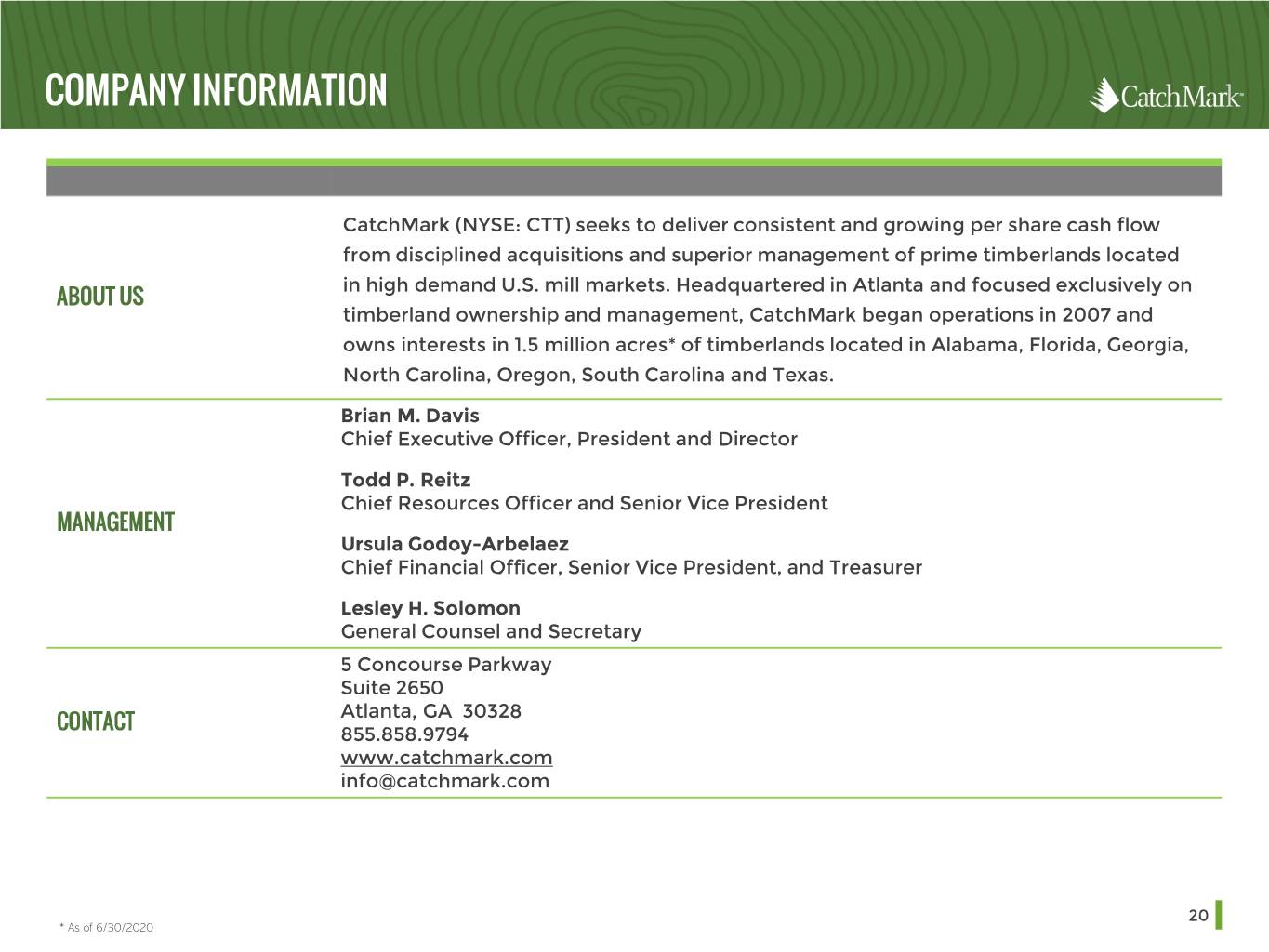
COMPANY INFORMATION CatchMark (NYSE: CTT) seeks to deliver consistent and growing per share cash flow from disciplined acquisitions and superior management of prime timberlands located in high demand U.S. mill markets. Headquartered in Atlanta and focused exclusively on ABOUT US timberland ownership and management, CatchMark began operations in 2007 and owns interests in 1.5 million acres* of timberlands located in Alabama, Florida, Georgia, North Carolina, Oregon, South Carolina and Texas. Brian M. Davis Chief Executive Officer, President and Director Todd P. Reitz Chief Resources Officer and Senior Vice President MANAGEMENT Ursula Godoy-Arbelaez Chief Financial Officer, Senior Vice President, and Treasurer Lesley H. Solomon General Counsel and Secretary 5 Concourse Parkway Suite 2650 Atlanta, GA 30328 CONTACT 855.858.9794 www.catchmark.com info@catchmark.com 20 * As of 6/30/2020



















